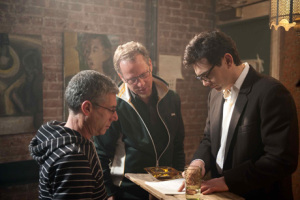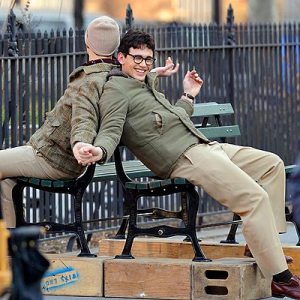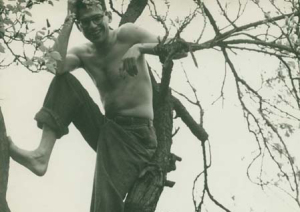Howling for authentic biographical cinema: Why the new Ginsberg film succeeds

When I was a teenage movie-watcher, I was the first to jump on the new-genre bandwagon whenever anyone tried something different that played with, bent or overlapped conventional film structure. Somewhere between those teenage years of wonder when everything was fascinating, and, like, 2008, I got burned by experimental filmmaking. Not enough to make me ever avoid the indie films I always had and always will gravitate toward, but enough to make me go into them slightly wary and, perhaps, not expecting to be bowled-over like I expected to be when I was fifteen, and admittedly more bowl-over-able.
 This year, I was bowled over like a fifteen year-old again by directors Rob Epstein and Jeffrey Friedman’s amazing new film about Ginsberg, his infamous poem Howl and the subsequent obscenity trial. Howl (2010) is an effort the directors called a ‘hybrid film’: fully dramatized (stunningly and perfectly by a quietly buoyant James Franco), but with documentary-like sequences and gorgeous animated interludes. The directing duo’s previous works included The Celluloid Closet (1996) and Epstein’s The Times of Harvey Milk (1984), documentaries which I already loved, but these were traditional docs, without actors in the roles. And even if they weren’t (like Gus Van Sant’s Milk (2008), which I also adored), dramatizing the lives of creative people—writers, artists, musicians—creates different challenges than dramatizing the lives of historical or other figures. The nature of the entertainment careers of creative people provide archiving that is more thoroughly ingested by the public, and that asserts itself as a strong, recognizable precedent in the artist’s look, voice, demeanor and je ne sais quoi. Ours is an entertainment-driven culture more than a historically-driven one, partly because of the deep personal fulfillment people glean from the arts. This strong attachment sometimes results in beloved creators being viewed as sort of enigmatic beings, a highly non-specific and interpretive construct for an actor to try to replicate. Playing an artist is in no way harder than playing any other type of historical figure, but I believe that actors in non-artist biographical roles are more easily accepted by the audience overall, whereas when actors play artists, there are more opportunities to misstep in the eye of the film consumer and their preconceived idea of how their favorite musician or writer should be represented on screen. So while I went into Van Sant’s Milk already knowing I would love it, I was excited to see Howl, but didn’t know what to expect.
This year, I was bowled over like a fifteen year-old again by directors Rob Epstein and Jeffrey Friedman’s amazing new film about Ginsberg, his infamous poem Howl and the subsequent obscenity trial. Howl (2010) is an effort the directors called a ‘hybrid film’: fully dramatized (stunningly and perfectly by a quietly buoyant James Franco), but with documentary-like sequences and gorgeous animated interludes. The directing duo’s previous works included The Celluloid Closet (1996) and Epstein’s The Times of Harvey Milk (1984), documentaries which I already loved, but these were traditional docs, without actors in the roles. And even if they weren’t (like Gus Van Sant’s Milk (2008), which I also adored), dramatizing the lives of creative people—writers, artists, musicians—creates different challenges than dramatizing the lives of historical or other figures. The nature of the entertainment careers of creative people provide archiving that is more thoroughly ingested by the public, and that asserts itself as a strong, recognizable precedent in the artist’s look, voice, demeanor and je ne sais quoi. Ours is an entertainment-driven culture more than a historically-driven one, partly because of the deep personal fulfillment people glean from the arts. This strong attachment sometimes results in beloved creators being viewed as sort of enigmatic beings, a highly non-specific and interpretive construct for an actor to try to replicate. Playing an artist is in no way harder than playing any other type of historical figure, but I believe that actors in non-artist biographical roles are more easily accepted by the audience overall, whereas when actors play artists, there are more opportunities to misstep in the eye of the film consumer and their preconceived idea of how their favorite musician or writer should be represented on screen. So while I went into Van Sant’s Milk already knowing I would love it, I was excited to see Howl, but didn’t know what to expect.

Directors Friedman and Epstein with James Franco
It’s a little unfair to compare this aspect of Epstein’s and Friedman’s directing to a traditional director, because obviously filmmakers with a background in documentary film are better-equipped to handle the recreation of history. And in general, American films are notoriously bad at representing time periods (“A film in the 20s? Okay, we need. . . red lipstick, and. . . a bob haircut. And one of those huge radios that looks like a sideboard. Voila! We’re done!”) But the thing I loved most about Howl is that the focus was entirely on Ginsberg himself and the events. Even style of the animated sequences were designed by the marvelous Eric Drooker, an artist who collaborated directly with Ginsberg late in the poet’s life.

Aaron Tveit as Peter Orlovsky and Franco as Ginsberg
However, the problem with getting too interpretive with biopics is the potential for the personal ownership the director feels for the subject to circumvent their desire to serve the creative person themself. Too much personal interpretation by a director in a biographical film can do a disservice to the audience by encapsulating the subject in the director’s own experience. This is meaningful to the director, but it creates a static vacuum where the audience is tunneled into the director’s own feelings toward the subject and potentially out of their own. It can come off as self-indulgent to assume that your personal interpretation of a well-known creative figure is more relevant than what you would allow the audience to take away from the film if you do it to only serve the person whom the film is about, like the directors did with Howl.
I know sometimes, the director doesn’t have a choice. For instance, in the production of I’m Not There (2007), Todd Haynes was in a double-bind because there was no way Bob Dylan would ever, ever allow anyone to do a straight biopic of his life. The reason I’m Not There was made at all was because it was a highly abstracted film-idea based interpretively around Dylan’s life, songwriting and ideas of himself. Don’t get me wrong, I really enjoyed I’m Not There (and who didn’t love seeing Cate Blanchett’s Dylan?), but I’m curious whether the narrative would be easy to follow if you weren’t already a hardcore Dylan fan with a lot of previous knowledge of the musician or hadn’t already watched Martin Scorsese’s 4-hour Bob Dylan documentary epic, No Direction Home (2005).

Allen Ginsberg
History is history, and interpretive social context changes over time. For this reason, biographical films like Milk and Howl that try to present factual portraits of their subjects have the potential to remain the most powerful, watchable and memorable over time; because you remember the subject themself, not how they may have been reconfigured by, or impacted the creative life of, the director.
Comments
3 Responses to “Howling for authentic biographical cinema: Why the new Ginsberg film succeeds”Trackbacks
Check out what others are saying...-
[…] My newest piece for The Idler talks about the new Ginsberg biopic and why it’s a great example of the alternative biographical film genre. Read Howling for authentic biographical cinema: Why the new Ginsberg film succeeds […]
“(“A film in the 20s? Okay, we need. . . red lipstick, and. . . a bob haircut. And one of those huge radios that looks like a sideboard. Voila! We’re done!”)”
I feel like often times filmmakers are making period films based on OTHER period films, and not the period itself. More specifically, they are making homage films, like the Coen brothers great homage to the gangster film, “Miller’s Crossing”, but less intentional.
Biopics are tricky because they need to both inform and entertain. There are many amazing people in this world who have done amazing things. Not ALL of them would make for a great film subject. Let’s face it, sometimes the trip there just isn’t that dramatically interesting!
I’m looking forward to checking out “Howl”, and I am a big fan of “Milk” as well.
That’s a great point. The further we get from any given time period, the more caricaturized it becomes. Looking to other period films instead of the period itself will eventually leave us with Halloween-costume like representations. I don’t know if there’s some unwritten rule that too much time-period recreation will frighten contemporary audiences, or if the industry is just apathetic about the whole thing ;)